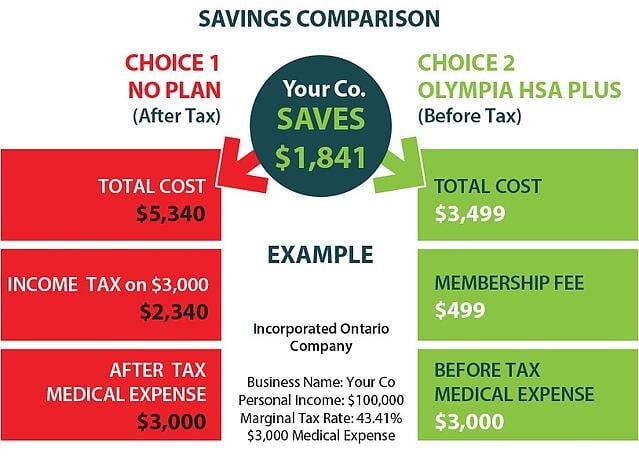Over the course of nearly 20 years in the Cost Plus industry, I have heard and seen thousands of small business owners searching for an affordable means to pay for their medical expenses.
I think the Cost Plus provides a unique solution. Here's the Canadian small business owner's fast guide to understanding this type of benefit plan.
Please note that the term "Cost Plus" is commonly referred to as a Health Spending Account / HSA or Private Health Services Plan / PHSP.
1. What is Cost Plus insurance?
Cost Plus is a health and dental benefit plan that offers a different way to pay for medical expenses compared to a regular insurance plan. Used by tens of thousands of small business owners across Canada (Olympia has approximately 58,000 business owners using our plans), a Cost Plus is a special account that is established to exclusively pay for health care services for you and your family members.
Cost Plus enables a small business to deduct 100% of their family health and dental expenses - without paying standard premiums typically associated with traditional health insurance plans.
The ability to write off health and dental expenses can create savings of more than 30% on medical and dental related expenses. For entrepreneurs and self employed professionals, this is an effective tool to cut your taxes and reduce your medical costs.
For a company with many employees, the Cost Plus format becomes a means for attracting and retaining talent due to its unique properties. All benefits within a PHSP are 100% tax free to employees. This type of plan provides significant cost control to the employer and flexibility for employees.
2. Do I qualify?
You are an excellent candidate for a Cost Plus insurance plan if you own a business, have medical bills, and pay income tax.
3. How will a Cost Plus save me money?
This type of benefit plan will save you money in three ways:
- Tax savings from deducting 100% of your medical costs
- Reducing your costs by avoiding high premiums associated with traditional health insurance
- The elimination of expensive deductibles
Below is an example of a savings comparison between an out of pocket and business medical expense.

Choice 1 – Out of Pocket: After Tax Medical Expense
The medical expense could represent a year's worth of uncovered expenses that has been paid for by you, personally, with out of pocket after tax dollars. After tax dollars is the amount remaining after personal income tax is paid. In this example’s tax bracket, the company will distribute $7,120 (before tax), with 43% reserved to pay income tax ($3,120).
To explain in detail, each $1 you spend on medical expenses requires your company to pay you approximately $1.78 before tax. 43% (or 78 cents) is paid in tax to Canada Revenue Agency in the form of provincial and federal taxes.
Choice 2 – Cost Plus (or HSA): Before Tax Medical Expense
In this case, the medical expense is paid through your corporation as a before tax business expense. Effectively, you are able to write off 100% of your medical expense through your corporation. Value is created by keeping the additional 43% tax inside your corporation.
The pricing of the Cost Plus will vary by provider. In this example the yearly (total) cost of the HSA is $499. Olympia has plans ranging from $249 per year for an incorporated professional with no employee to a Cost Plus 8% for a business with employees.
4. Is Cost Plus insurance effective for an owner/operator/one person business?
See 3 Reasons a one person business uses a PHSP / HSA
This category of businesses includes incorporated consultants and contractors, and professional corporations. This segment of Canada's business community is overlooked by traditional health insurance carriers as it is difficult and expensive to insure.
Interestingly, it can be argued that a Cost Plus insurance is most effective for a one person business. The majority of Olympia clients are owner/operator businesses. By using this plan, you and your family would benefit from a 100% tax deduction for your family medical benefits.
For the average family in Canada, the annual medical expenses can easily amount to $3000. A typical, healthy, family may only need to have a visit to the dentist for each family member, a pair of glasses, and a few prescription drugs to reach that amount. Depending on your personal tax rate and province of residence, your savings with a PHSP can range from about $500 to over $2,000.
Here's some of the advantages of the plan for an owner/operator/one person business:
- Deduct 100% of your family's medical expenses
- Reduce your business and personal taxes
- Get comprehensive medical coverage of all the routine expenses with few limits
- Pay less than you do today in premiums for an insured health and dental coverage
- Supplement plans held by a spouse who is employed outside your business
5. What types of health and dental expenses are covered under a Cost Plus benefit plan?
One of the great benefits of a Cost Plus program is the freedom it provides through the  extensive range of eligible expenses. Forget about restrictions. You'll love being able to claim 100% of your child's dental braces. These types of expenses along with a thorough list of qualified medical practitioners, procedures, and medical devices helps make Health Spending Account an attractive choice for the small business owner.
extensive range of eligible expenses. Forget about restrictions. You'll love being able to claim 100% of your child's dental braces. These types of expenses along with a thorough list of qualified medical practitioners, procedures, and medical devices helps make Health Spending Account an attractive choice for the small business owner.
Unlike many traditional insurance plans, a Cost Plus Insurance offers 100% coverage on a wide range of expenses...even the expensive ones. Does your son need physiotherapy? Does your spouse need a new pair of glasses or maybe laser eye surgery? Maybe you want to get an MRI? Rest assured, all of these are eligible expenses with a Cost Plus plan.
You can even claim your spouse's premiums if they are a member of a traditional insurance plan. That's right. Premiums contributed to a non-government insurance plan are an eligible expenses with a Cost Plus. How great is that?!
Do you have unpaid portions that are not covered from your spouse's plan? Not a problem - the remaining amount of an expense is eligible with a Cost Plus benefits plan. Fantastic.
Prescription drugs, massage therapy, and hearing aids are all eligible expenses too. If you are traveling to the sun on your upcoming vacation...pick up a pair of prescriptions sunglasses so you can read on the beach (the sunglasses are eligible as well). Sore feet from that long hike or fishing trip? Pay a visit to your friendly Podiatrist as all of their services are eligible expenses.
6. Are my dependants covered?
Dependants are eligible with few restrictions.
7. How does the Cost Plus compare to a traditional health insurance plan?
There are several advantages of a Cost Plus compared to a traditional health insurance plan. Premiums, expense eligibility, ease of use, deductibles, and claims are some of the areas an Cost Plus is considered more favorable. Understanding the difference between insurance and administration is critical when deciding on how to pay for your medical expenses.
Here's 5 reasons the Cost Plus is better than a traditional health insurance plan.
1. Premium Creep
Traditional Insurance Plan
- Monthly premium for coverage regardless of access or usage to the plan
- Monthly premium rate often increased at the annual renewal of the policy (premium creep)
- Age of the individual will affect the price of your plan
PHSP
- Avoid a premium creep due to usage or age factors
- Most Health Spending Accounts have fixed fee as opposed to a premium
- Pay for the expenses you incur, eliminating a situation where you have paid into a program that you did not use.
2. Eligible Expenses and Pre-existing Conditions
Traditional Insurance Plan
- Eligible medical expenses are restricted
- Items that you wish to claim under this policy may be restricted by an annual or life time maximum or require special authorization in order to obtain eligibility.
- At time of enrollment, medical history will be requested and pre-existing conditions may be excluded or reduced from coverage.
PHSP
- Expenses are not restricted by type of expense, only on the dollar amount
- You will have access to a wider range of eligible expenses
- Will not restrict or limit benefits due to a pre-existing medical condition
3. Complexity
Traditional Insurance Plan
- Under a fully insured program, you will receive a plan booklet outlining the items that are covered and also the ones restricted or excluded by definition, co-insurance, deductibles or fee guides. Figuring out what your coverage is and if it will be reimbursed partially or in full can get complicated.
PHSP
- A Cost Plus is typically only restricted by dollar amount. You will have 100% coverage for all eligible expenses up to your spending account limit. Your account balance is updated by the administrator every time a claim is processed, eliminating the need to keep track of this information manually.
4. Deductibles
Traditional Insurance Plan
- Your benefits may be restricted by an annual single/family deductible
- Benefits can be restricted by a co-insurance of 50%-80%
- There is a limit for the number of visits and treatments.
Cost Plus
- No deductible
- You are not restricted by co-insurance
- No limits for the number of visits and treatments
5. Claims
A PHSP with a digital claim platform will process your claim within 24 hours versus many traditional insurance claims that can take several weeks to process.
8. Do I qualify for a Cost Plus plan even though I have a pre-existing condition?
Yes, you qualify. Pre-existing conditions do not affect your eligibility for a Cost Plus.
9. How does a Cost Plus claim work?
- Pay for your medical expense (let’s say with your personal credit card). (Pay provider $1,000)
- Make an online claim (enter your expense details, submit the claim, make a payment from your corporation for the amount of your expense). (Pay the administrator $1,000 from your corporation)
- The administrator reimburses your personal banking account for the original expense ($1,000)
The payment from your corporation to the administrator is 100% tax deductible. The reimbursement you receive from the administrator is 100% tax free.
See the top 9 FAQ on the claim process.
10. Is there a limit to how much I can deduct?
There are several factors that determine the limits within a Cost Plus. A reasonable maximum benefit level for an incorporated business owner is $15,000 per year. If the business has additional employees, the business owner is able to determine specific amounts for each classification of employee (management, full time, etc).
11. How much does an Cost Plus cost?
Prices for a Cost Plus can vary as with most other products. An administrator can charge an upfront setup fee, an ongoing administration fee based on the amount of your claims, a maintenance fee, or sometimes these fees are replaced with a fixed annual fee. Here's an example of the pricing for a family plan Cost Plus that uses a fixed annual fee format.
Technical Stuff
12. Can I set up a Cost Plus myself?
In theory, you can self administer a Cost Plus for your business. You can also do your own accounting, legal work, and website development. The fact of the matter is time is your most valuable asset and you would need to determine if you have the expertise and resources at hand to properly establish, organize, and maintain your own plan. Are you going to be able to dedicate scarce resources to the administration of your Cost Plus?
Strict guidelines and conditions are required to qualify a Cost Plus and ongoing knowledge is required to properly adjudicate claims. In exchange for a small fee to a provider, you can be worry free that your Cost Plus qualifies with CRA and focus your time on your business and more important matters.
Moreover, what happens if you are audited and there is a problem with your plan? Having a third party administrator gives you an added layer of protection and signals your HSA is the hands of an expert that is well equipped in the specifics and intricacy of this financial product.
13. What can I give my accountant?
Although straightforward to use, a Cost Plus does require proper explanation and understanding before it is adopted by any particular small business. A Cost Plus directly involve matters of taxation and ultimately some small business owners speak with their accountant for clarification. You can forward this article and guide to your accountant for review.
14. Are Cost Plus benefits legal? Given they involve taxes, does it comply with Canada Revenue Agency?
Yes! Cost Plus benefit plans are legal in Canada - as long as the guidelines are properly adhered to. To properly satisfy the conditions set forth by CRA, make sure you choose a reputable provider and understand what you are purchasing.
13. When will my Cost Plus become effective?
Effective dates for a Cost Plus plan are an important component for CRA eligibility. A Cost Plus is effective immediately on the day you join and cannot be backdated to the beginning of your fiscal year. There are no waiting periods.
15. How long has the Cost Plus concept been around?
The Cost Plus has been available since the 1980's. Olympia Benefits is a pioneer and largely responsible for the initial marketing and promotion of the concept to Canada's small business community. Since 1996, Olympia has been marketing and administering PHSPs.
16. What's the difference between an Cost Plus benefit plan and insurance?
A Cost Plus plan is a tax plan in the nature of insurance. It looks, smells, and feels like insurance since it deals with medical costs. The critical difference however, is that by paying for medical expenses through a Cost Plus plan, you are self-insuring. There are significant advantages to paying for medical expenses through a tax plan instead of an insurance plan.
17. Are there different types of Cost Plus programs?
Once you get past all the marketing jazz, the Cost Plus is a contract. Specifically, it is a contract between an employer (a business) and an employee. The conditions of the contract should outline the relationship between the employer, employee, and the administrator. So in that sense, all Cost Plus / HSA / PHSP are the same.
However, there are some key conditions that will affect the outcome of the Cost Plus program. Are there arm's length employees? What type of compensation does the owner receive (dividends)? Are the employees part time?
18. How do you select the right Cost Plus provider?
For the most part, Cost Plus benefit plans are marketed and administered by reputable firms with a proven and documented track record. Unfortunately, the industry is unregulated and there are no barriers to entry. Make sure you dig beneath the surface and find out the warnings signs of a Cost Plus provider that is cutting corners. Are you comfortable sending a $10,00 cheque to a PO Box?
19. Why are Cost Plus plans less common than insurance?
Large providers of traditional health and dental insurance in Canada are very adept at marketing. In fact, they are so effective at developing and delivering targeted messaging that many small Canadian business owners firmly believe that purchasing traditional insurance is a must to effectively protect themselves and their families.
Are you a small business owner in Canada? Discover how the Olympia Cost Plus/ HSA will reduce your medical costs and lower your taxes.
